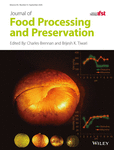Effects of carrageenan oligosaccharide on lipid, protein oxidative changes, and moisture migration of Litopenaeus vannamei during freeze–thaw cycles
Abstract
The effects of carrageenan oligosaccharide on lipid, protein oxidative changes, and moisture migration of Pacific white shrimp (Litopenaeus vannamei) were evaluated, respectively, during repeated freeze–thaw (F–T) cycles. Distilled water (CK), sodium tripolyphosphate (ST), and carrageenan oligosaccharides (CO) were subjected to samples with different freeze–thaw cycles. Lipid oxidation was determined by lipid content, peroxide value (PV), thiobarbituric acid-reactive substances (TBARS) value, and free fatty acids (FFA). Protein oxidative denaturation and degradation were analyzed by carbonyl content, surface hydrophobicity, sulfhydryl content (SH), and sodium dodecyl sulfate-polyacrylamide gel electrophoresis (SDS-PAGE). Low field nuclear magnetic resonance (LF-NMR) was performed to reflect moisture migration. Dynamic rheology and Differential Scanning Calorimeter (DSC) were also carried out to analyze the changes of protein in L. vannamei. When compared with CK and ST groups, carrageenan oligosaccharide was more effective in controlling the changes of lipid and protein in samples during F–T cycles with lower contents of TBARS, PV, FFA, surface hydrophobicity, carbonyl and higher contents of lipid, SH and immobilized water. The data of DSC, dynamic rheology, and SDS-PAGE showed that carrageenan oligosaccharide could protect the structure of myosin and sarcoplasmic protein significantly. Therefore, as an alternative cryoprotectant, carrageenan oligosaccharides could be applied during the processing of L. vannamei.
Practical applications
The oxidation of lipid and protein, the frozen denaturation of protein and decrease of functional characteristics easily occurred to Pacific white shrimp, which leads to the decrease of nutritional value and eating quality during repeated F–T. Carrageenan oligosaccharides that have been recognized as playing considerable roles in numerous biochemical changes that have been shown related to antioxidant activity both in a cell system and in vitro. During freezing and thawing cycles, the protein and lipid oxidation of shrimp treated with carrageenan oligosaccharide were lower, and the water retention capacity and content of muscle were higher. Carrageenan oligosaccharide has a good regulatory effect on protein and lipid changes in Litopenaeus vannamei during repeated F–T. The research has illustrated the potential of carrageenan oligosaccharide as a lipid, protein, and water protectant of L. vannamei during repeated F–T.
CONFLICT OF INTEREST
The authors have declared no conflicts of interest for this article.




